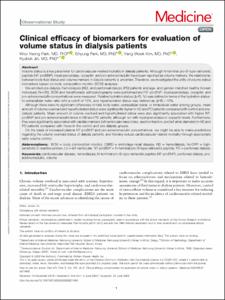KUMEL Repository
1. Journal Papers (연구논문)
1. School of Medicine (의과대학)
Dept. of Internal Medicine (내과학)
Clinical efficacy of biomarkers for evaluation of volume status in dialysis patients
- Keimyung Author(s)
- Park, Woo Young; Jin, Kyu Bok
- Department
- Dept. of Internal Medicine (내과학)
- Journal Title
- Medicine
- Issued Date
- 2020
- Volume
- 99
- Issue
- 31
- Keyword
- ardiovascular disease; hemodialysis; N-terminal pro-B-type natriuretic peptide (NT-proBNP); peritoneal dialysis; proadrenomedullin; volume
- Abstract
- Volume status is a key parameter for cardiovascular-related mortality in dialysis patients. Although N-terminal pro-B-type natriuretic peptide (NT-proBNP), myeloperoxidase, copeptin, and pro-adrenomedullin have been reported as volume markers, the relationship between body fluid status and volume markers in dialysis patients is uncertain. Therefore, we investigated the utility of volume status biomarkers based on body composition monitor (BCM) analyses.
We enrolled pre-dialysis, hemodialysis (HD), and peritoneal dialysis (PD) patients and age- and gender-matched healthy Korean individuals (N = 80). BCM and transthoracic echocardiography were performed and NT-proBNP, myeloperoxidase, copeptin, and pro-adrenomedullin concentrations were measured. Relative hydration status (ΔHS, %) was defined in terms of the hydration status-to-extracellular water ratio with a cutoff of 15%, and hyperhydrated status was defined as ΔHS > 15%.
Although there were no significant differences in total body water, extracellular water, or intracellular water among groups, mean amount of volume overload and hyperhydrated status were significantly higher in HD and PD patients compared with control and pre-dialysis patients. Mean amount of volume overload and hyperhydrated status were also significantly associated with higher NT-proBNP and pro-adrenomedullin levels in HD and PD patients, although not with myeloperoxidase or copeptin levels. Furthermore, they were significantly associated with cardiac markers (left ventricular mass index, ejection fraction, and left atrial diameter) in HD and PD patients compared with those in the control and pre-dialysis groups.
On the basis of increased plasma NT-proBNP and pro-adrenomedullin concentrations, we might be able to make predictions regarding the volume overload status of dialysis patients, and thereby reduce cardiovascular-related mortality through appropriate early volume control.
- Publisher
- School of Medicine (의과대학)
- Citation
- Woo Yeong Park et al. (2020). Clinical efficacy of biomarkers for evaluation of volume status in dialysis patients. Medicine, 99(31), e21460. doi: 10.1097/MD.0000000000021460
- Type
- Article
- ISSN
- 1536-5964
- Source
- https://journals.lww.com/md-journal/Fulltext/2020/07310/Clinical_efficacy_of_biomarkers_for_evaluation_of.97.aspx
- Appears in Collections:
- 1. School of Medicine (의과대학) > Dept. of Internal Medicine (내과학)
- 파일 목록
-
-
Download
 oak-2020-0492.pdf
기타 데이터 / 403.07 kB / Adobe PDF
oak-2020-0492.pdf
기타 데이터 / 403.07 kB / Adobe PDF
-
Items in Repository are protected by copyright, with all rights reserved, unless otherwise indicated.